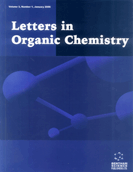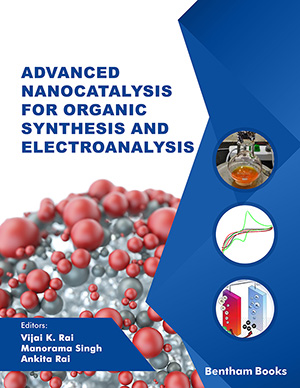
Abstract
Background: Functional organic dyes with donor-π-conjugation-acceptor (D-π-A) molecular structure and electron transfer in the excited state have attracted much attention because of their potential applications in optical, electronics, magnets materials, dye sensitized solar cells (DSSCs), organic light emitting diodes (OLED), sensors, solid state lasers and photovoltaic cells and thin film transistors.
Methods: An efficient and convenient method for synthesis of 2,6-bis-[2-(4-dialkylaminophenyl) vinyl]- 4H-Pyran-4-one starting from reaction of 4-fluorobenzaldehyde with 2,6-dimethyl-4H-pyran-4- one in the presence of MeONa as base was described. In continuation, secondary amines were reacted with 2,6-bis((E)-4-fluorostyryl)-4H-pyran-4-one and 2,6-bis-[2-(4-dialkylaminophenyl)vinyl]-4HPyran- 4-one was obtained as the final product. 1H and 13C NMR, FT-IR spectroscopy supported the predicted structure of the products. The UV-Vis absorption spectra of synthesis compound were measured in diluted dichloromethane solution.
Results: Knoevenagel reaction of 4-fluorobenzaldehyde and 2,6-dimethyl-4H-pyran-4-one to afford 2,6-bis((E)-4-fluorostyryl)-4H-pyran-4-one was performed in room temperature.To optimize the reaction conditions, a variety of solvents (EtOH, MeOH, t-BuOH) and bases (KOH, NaOH, EtONa, Me- ONa, t-BuONa) were tested; MeOH/MeONa system was selected as the best condition for this step. The best operative system for nucleophilic aromatic substitution of secondary amines with 2,6-bis((E)- 4-fluorostyryl)-4H-pyran-4-one was obtained when DMF was used as a solvent and K2CO3 was employed as the base and HDTMAB as ligands. In addition, malononitrile was reacted with 2,6-bis((E)-4- fluorostyryl)-4H-pyran-4-one and obtained compound was employed in SNAr reaction. The UV-Vis spectroscopy studies were carried out in diluted dichloromethane solution (5×10-5 M) on the synthesized bis-condensed DCM derivatives.
Conclusion: In summary, this study focused on preparation of novel compounds with bis-DCM-type skeleton for application in organic light-emitting diodes, for this purpose, 2,6-bis-[2-(4-dialkylaminophenyl) vinyl]- 4H-Pyran-4-one derivatives were prepared from reaction of 4-fluorobenzaldehyde with 2,6-dimethyl- 4H-pyran-4-one in the presence of MeONa as base. In continuation, secondary amines were reacted with 2,6-bis((E)-4-fluorostyryl)-4H-pyran-4-one and 2,6-bis-[2-(4-dialkylaminophenyl) vinyl]-4HPyran- 4-one was obtained as the final product. Additionally, reaction of malononitrile as an active methylene group with 2,6-bis((E)-4-fluorostyryl)-4H-pyran-4-one before N-arylation reaction resulted in 2-(2,6-bis(4-(dialkylamino)styryl)-4H-pyran-4ylidene)malononitrile derivatives.
Keywords: Bis-DCM, malononitrile, push-pull system, SNAr, organic light-emitting diodes (OLED), Knoevenagel condensation.
 25
25 2
2 1
1
























